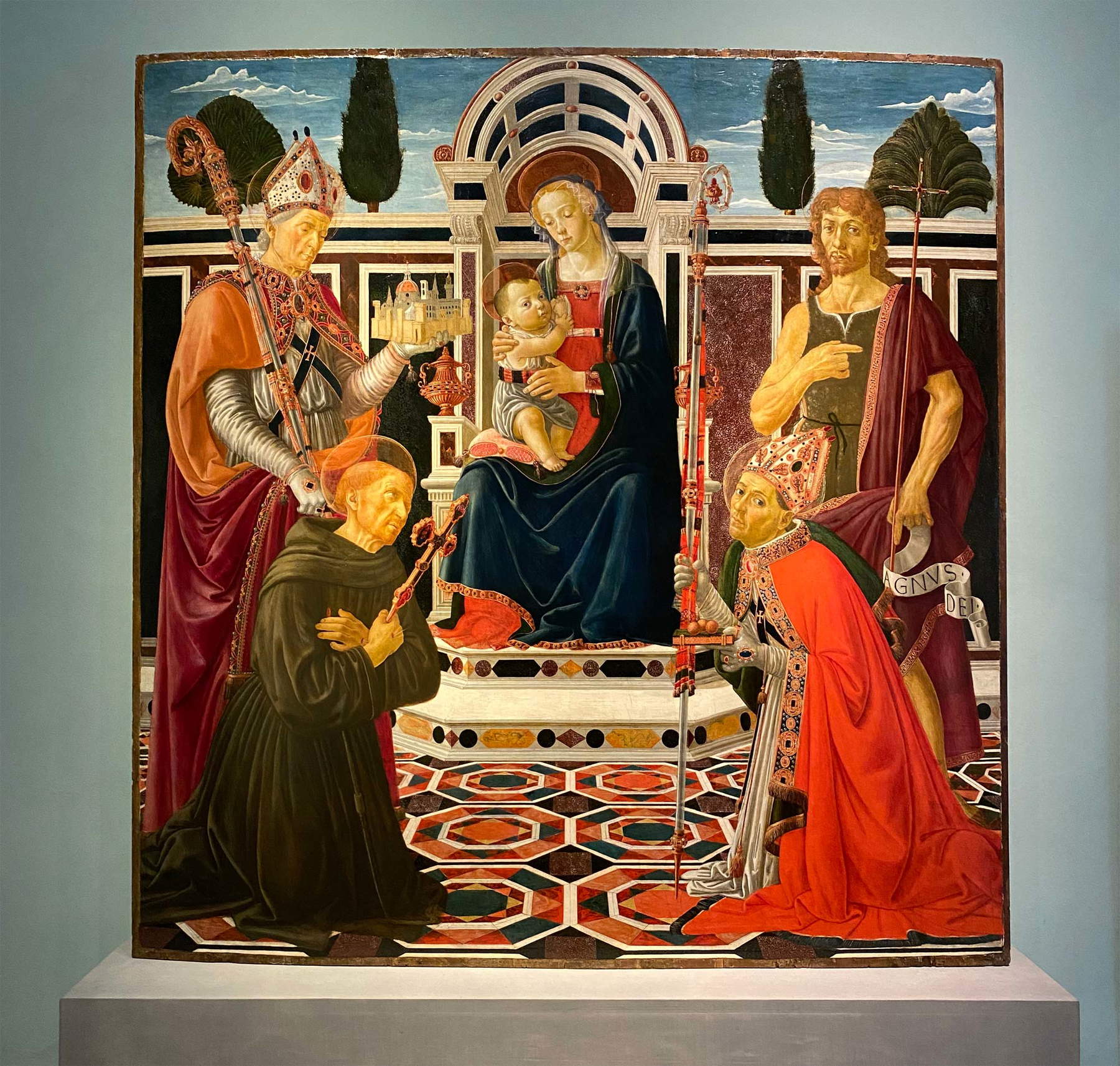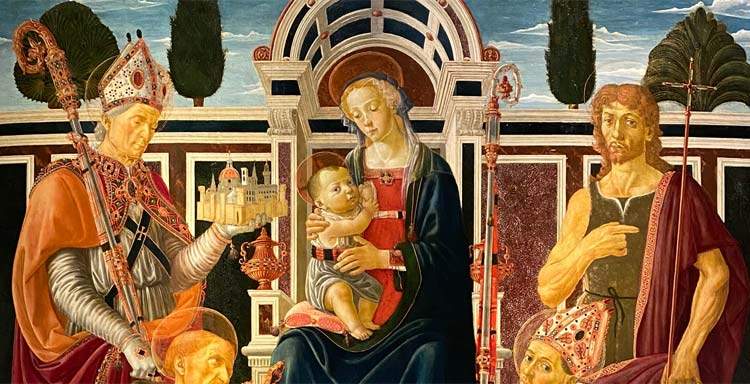In Florence , the Uffizi exhibits an important work by the school of Verrocchio, the Macinghi Altarpiece, owned by the museum but until now in external storage at the church of San Martino a Strada di Grassina (Florence), where it had been for nearly a century: the restoration work that the work underwent at theOpificio delle Pietre Dure has just been completed. The altarpiece, depicting the Sacred Conversation with Saints Zanobi, Francis John the Baptist and Nicholas, and called the “Macinghi Altarpiece” after the family for whom it was made, is the focus of the exhibition Verrocchio and his world in a misunderstood work: the restored Macinghi Altarpiece, on view until Feb. 19, 2023, on the second floor of the Uffizi, in the exhibition spaces between the rooms dedicated to Leonardo and those of Raphael and Michelangelo.
Part of the Gallery’s collection, in 1926, the altarpiece was sent to the church of San Martino a Strada, near Grassina, just outside Florence. The work is first mentioned, in the seventeenth century, in the church of Santissima Annunziata in Florence, where it most likely came from originally, perhaps as an altarpiece for the Macinghi family, a chapel now housing the Chapter House in the Cloister of the Dead. Its attribution to the school of Andrea del Verrocchio, at whose workshop were many important artists of the period, not only Leonardo, but also Perugino and Sandro Botticelli, has long been accepted. In that setting, a sort of hotbed of young talent, goldsmithing, bronze and marble sculptures, and paintings were produced. The various workers and students could practice using even the master’s drawings and collaborating in the execution of important works. This system of production was very frequent in artists’ workshops and made it possible, among other things, to complete works on time: the Baptism of Christ made for the church of San Salvi, in which Leonardo and perhaps Botticelli himself participated, is paradigmatic. The Madonna and Child between Saints Zanobi, Francis John the Baptist and Nicholas is a similar case, because its execution is due to more than one painter (at least three hands can be distinguished in the figures). The restoration of the painting, carried out by the Opificio delle Pietre Dure, has brought out the details of the embroidery and gems on the coats of the bishop saints, the extraordinary refinement of the goldwork, thesublime quality of the painting in the rendering of the materials, and the complex, studied architecture of the scene. A true jewel, then, is the model of the city of Florence offered by Saint Zanobi to Our Lady, in which the dome of the Duomo can be recognized in the center of several other city monuments, some of which have now disappeared.
At the Uffizi, the large altarpiece is displayed in dialogue with the Head of St. Jerome, a rare painting on paper autographed by Verrocchio, normally seen in the Galleria Palatina in Palazzo Pitti, a model that also recurs in the figure of St. Francis in the Macinghi Altarpiece.
The next stop for the altarpiece will be in Perugia, at the National Gallery of Umbria’s major exhibition dedicated to Perugino on the 500th anniversary of his death. The Macinghi Altarpiece (which was absent from the exhibition Verrocchio, Leonardo’s Master held at Palazzo Strozzi in 2019) thus returns to the limelight and is once again brought to the attention of scholars and the public at these two exhibition events, before being brought back to the church of San Martino a Strada. From Center to Periphery and Back.


“The Macinghi altarpiece,” comments Uffizi director Eike Schmidt, “was sent to San Martino a Strada from the deposits of the Florentine Galleries in 1926: the roots of the ’Uffizi diffuse’ thus go back a long way. Crucial now, however, is the expanded take that the museum is making of this excellent practice, not only by continuing to organize exhibitions in various centers of Tuscany, but (as in this case) by continuing to protect, in the territory, works of the Uffizi. The restoration of the Macinghi altarpiece, moreover, recovers and brings back to scholarly attention an important piece of Florence’s history.”
“On this occasion, I take for granted the excellent work carried out by the Opificio’s restoration laboratories, the result of the team that Marco Ciatti has been able to orchestrate over the years,” stresses Emanuela Daffra, superintendent of the Opificio delle Pietre Dure. “Instead, I propose a reflection from my own museum experience. All the great Italian institutions in past centuries and until recent years have, for various reasons, disseminated their collections. It is a practice that adds complexity to the life of the works. Entrusting their restoration to institutions such as the OPD, capable of tackling this ball of yarn head-on and unraveling it, makes it possible not only to ensure conservation, but to gather elements that enrich the history of both the work and the institution of origin and the territory that hosts it It is not obvious and it is invaluable: the altarpiece being presented today is an example of this.”
“During the diagnostic investigations prior to the restoration,” explains Cecilia Frosinini of the Uffizi Scientific Committee, and former director of the OPD’s sector of restoration of paintings on panel and canvas, "an inscription became visible again on the back of the work that was attested by eighteenth-century descriptions: ’Begun on April 6 and finished on the following July 15, 1472.’The inscription can be glimpsed with the naked eye, but is more legible in IR reflectography. It is traced in charcoal, with fifteenth-century handwriting, much paled from a conservation point of view, and interrupted by ancient restorations to the support.It attests, however, to an important and, at this point, certain chronological deadline for the execution of the work. The panel depicts the city of Florence, a model that Saint Zanobi offers as a gift to the Virgin: and the lantern of the dome of the Duomo bears the so-called ’ball,’ erected there by Verrocchio in 1471. A datum that therefore reconnects the chronological terms and autography of the painting."
“This restoration,” says Sandra Rossi, director of the OPD Canvas and Panel Restoration Sector, “is part of the fruitful collaborative relationship between the Opificio delle pietre dure and the Uffizi Galleries, a link between two great state and Florentine institutions that sees the Panel and Canvas Painting Restoration Sector engaged in interventions of extraordinary value, for complexity and quality of the works involved. Fortezza da Basso’s Laboratories make use of state-of-the-art diagnostic instrumentation and a prestigious network of collaboration with major national and international research centers. At the same time, its restorers express an operativeness and a wealth of skills that can well be compared to the prestigious workshop of Andrea del Verrocchio, in terms of mastery, quality and breadth of specializations. A close-knit teamwork of art historians, restorers and scientific experts that confirms the excellence of Florentine restoration in the world.”
 |
| At the Uffizi an exhibition on the Macinghi Altarpiece, a work from Verrocchio's workshop that has just been restored |
Warning: the translation into English of the original Italian article was created using automatic tools. We undertake to review all articles, but we do not guarantee the total absence of inaccuracies in the translation due to the program. You can find the original by clicking on the ITA button. If you find any mistake,please contact us.